Our Best Samurai Swords: The Forge Direct Custom Katana Reviewed

What are the best Samurai swords around (for under $1000?).
Until recently, my answer to this oft asked question was "it depends" - and with quite a few decent swords to choose from, there were few that truly stood out as the best of the best under this price point (and a few less than stellar examples too)..
If price is no object, then it is easy to answer - Japanese made Shinken are the best Samurai swords money can buy. The attention to even the smallest detail is evident in the Japanese monozukuri work ethic, and their swords are in many ways a quest for perfection..
But not everyone can necessarily afford the average price of a Japanese Shinken of $5-8K (which is very much the basic entry level for genuine Nihonto)..
So for the next best thing? Apart from Citdel Swords in Cambodia (who are in a league of their own) the next best Samurai swords would have to be those made by certified Master Smiths from the city of Longquan (the 'Dragon Well'), a city with over 2,600 years of blade making experience deep in the mountains of Zhejiang province and famous the world over for its swords.
We created such swords ourselves as part of Project X - producing a range of traditionally laminated Katana starting at around $1,100. But an offshoot of this project created such value packed blades that in short order we had inadvertently created some of the best value for money Katana ever made..
The Project was called the Forge Direct Custom Katana.
Read on to see why we feel this way, and you can make up your own mind if we achieved our at least came very close to our lofty goal of producing the best Samurai swords under $1000...
Forge Direct Custom Katana Series
Review by Paul Southren, Editor
|
Steel: Weight: Price Range: |
T10 Tool Steel 2-2.4lbs $779.99-$917.99 |
Please note that the current 4.0 version of this sword comes is available in only one blade length. It has also been upgraded to have hishigami used on the tsukas - otherwise the product is unchanged and exactly as presented here.
To truly determine how good the Project is and see for myself if these really were the best Samurai swords currently available outside of Japan, I commissioned the forge to make two swords for me from the available customization options - adding a few extra options to try out and add to the mix if they were any good..
The first sword was an O-Katana - and while I could have gone crazy with different ito wrap and rayskin colors (even dyed purple or bright red rayskin is an option) - I selected what I felt was a noble theme of traditional black ito, white rayskin, solid black sageo (the cord that attached the sheathe to a belt) and a rich brown maki-e saya with golden floral embellishments.

This sword was based on what I felt would be a tribute to the most legendary sword maker of all time - Masamune.
By contrast, for the second sword I chose a shorter blade (27" Nagasa) with black iron fittings, black saya, black handle with black rayskin - black on black on black..

This second sword was to be the antithesis of the first, and a tribute to the sinister, half mad sword maker of legend, Muramasa..
To achive an authentic Muramasa style blade, I requested that the forge add in a partial bo-hi around 6" long about 3" from the tsuba.
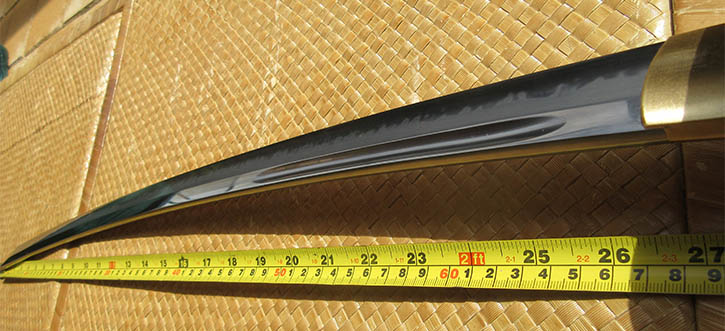
As you can see, it turned out more or less to spec. From the tip to the back notch of the habaki (blade collar) the Nagasa (length) came out to be 26.75" - and the partial bo-hi added a nice visual touch and also lightened the blade slightly - as I had in mind for it to be a fast and lethal slicer..
The O Katana on the other hand had the default O-Katana length of 33" from kissaki to munemachi (that notch on the back of the blade collar - the traditional way to measure a sword).
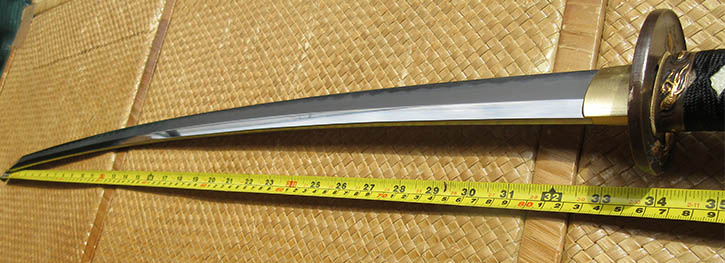
So far, everything was to spec.
The blades themselves were nice and thick at the spine, roughly a quarter of an inch.
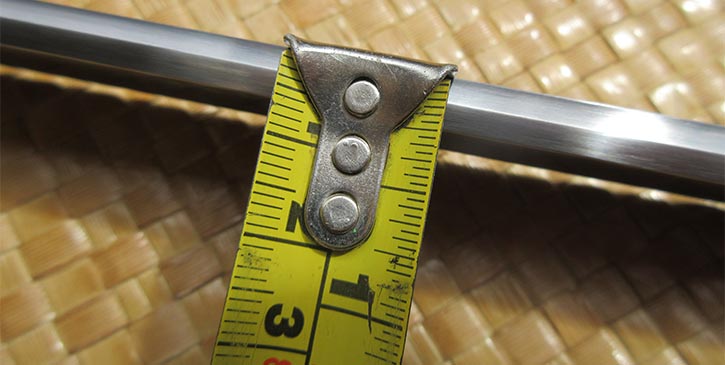
This part of the sword is called the mune (chest) and flowed cleanly to the habaki.
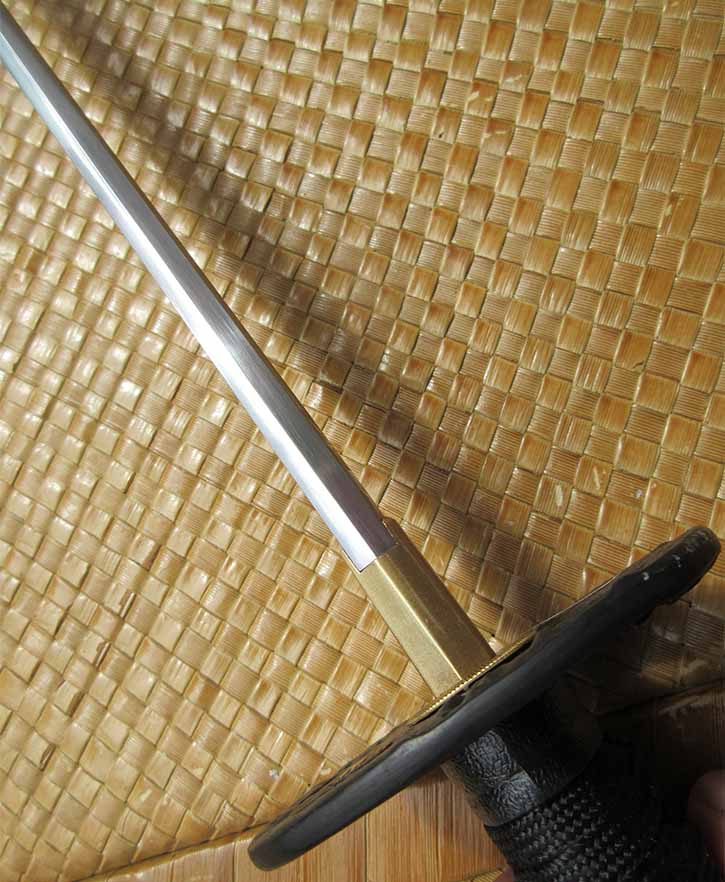
Below is a closer pic of the blade of the shorter Muramasa themed sword with partial bo-hi.
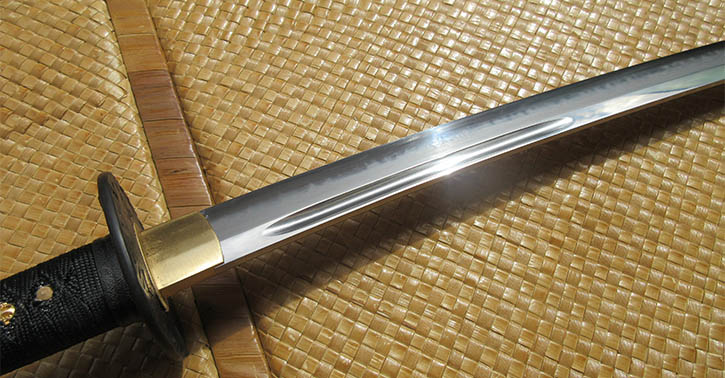
And here is one of the full length of the O-Katana. As you can see, it is one big sword (and only costs $100 more than the standard version).
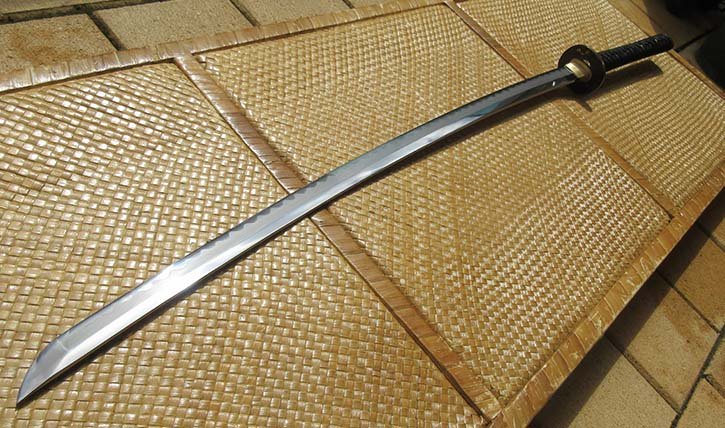
Now as you have probably noticed, each of these T10 tool steel blades is differentially hardened and has a natural, unetched and hand polished hamon temper line.
Currently we offer two types of hamon styles. The first is in a style called 'Choji Midare' and is very active and energetic and was selected for the shorter Katana.
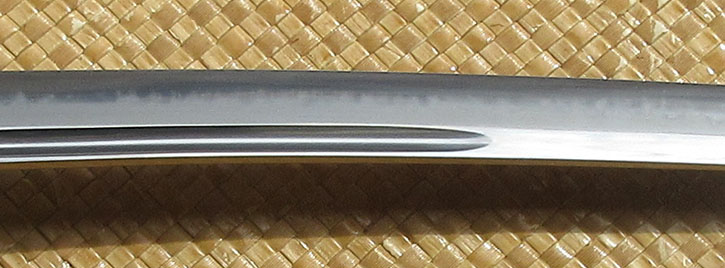
The O-Katana on the other hand has what is effectively a gunome midare hamon (midare basically means with some activity and irregular patterns in the hamon).
On this blade, there is also a couple of Tobiyaki - a couple of spots where the hamon 'jumps' off the main area (this is not a flaw, and sometimes done intentionally - sometimes done as a 'happy accident' and a nice touch).
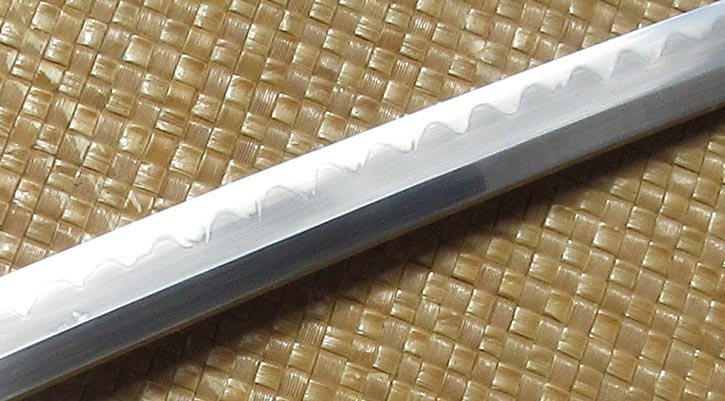
As you can see from the pictures below, some of the peaks of the hamon wave have intricate extensions giving them the appearance of snow covered mountain tops.
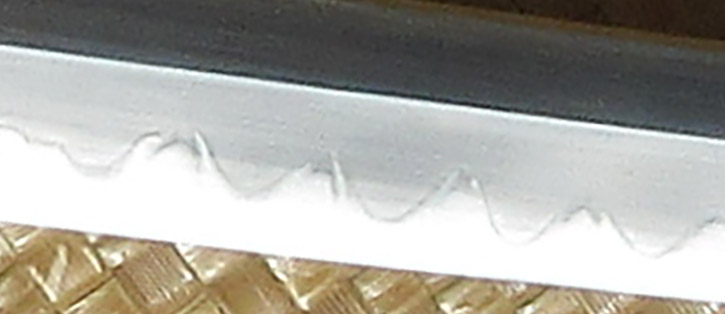
This kind of hamon activity you will only usually see in the very best Samurai swords, and is rarely seen on blades not produced in Japan.
Hats off to the Master Smiths for a job well done!
Closer to the kissaki tip, we see a well defined geometric yokote (intersection between the main blade and the tip).
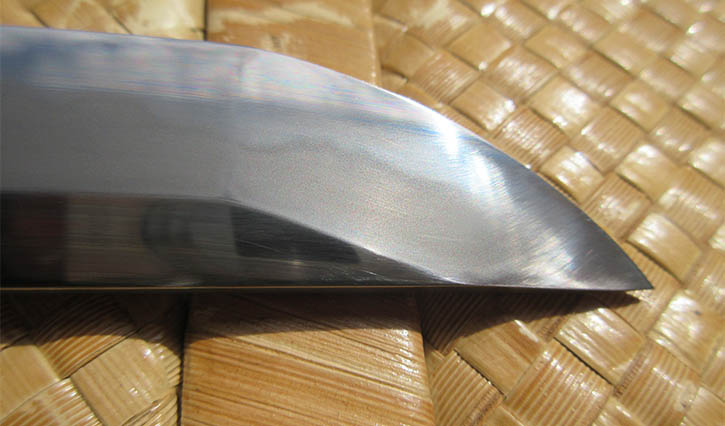
The hamon cleanly follows the curvature of the tip (called boshi) and is beautifully polished..
I can only guess how many hours went into polishing the tip alone (polishing a kissaki is almost as time intensive as polishing the length of the rest of the blade due to its irregular shape).
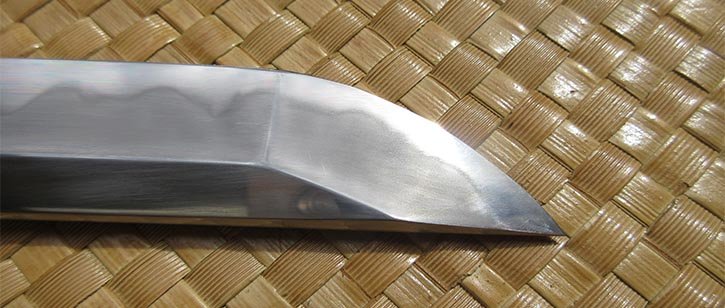
All in all, the blades were quite exceptional.
They were smoothly polished, with top quality hamon and perfectly honed.
So now, on to the nitty gritty of the designs.
Fittings and Customizations
Now as I mentioned, the Muramasa themed Katana was kept deliberately simple and dark in tone and character: black silk ito wrap, black rayskin, black iron fittings, black sageo and black saya.
The only colors, the two mekugi pegs (bamboo) and gold menuki (handle ornament) and gold highlights of the tsuba.
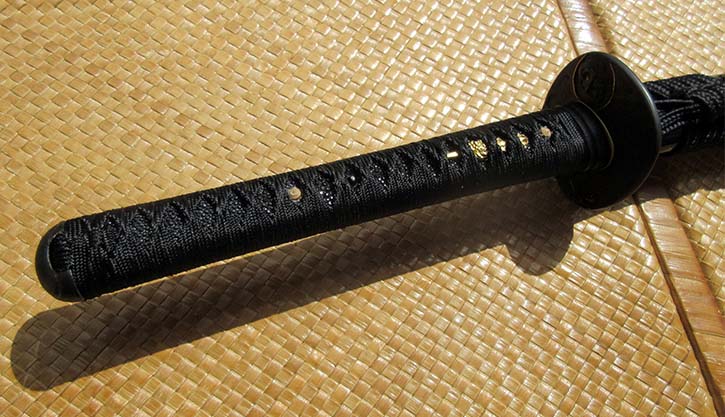
Because this was to be a somewhat sinister themed sword, I picked out the "i7 - Saint and Oni" with a demon on the left side seemingly praying for forgiveness to a Bodhisattva saint ringed with a gold halo..
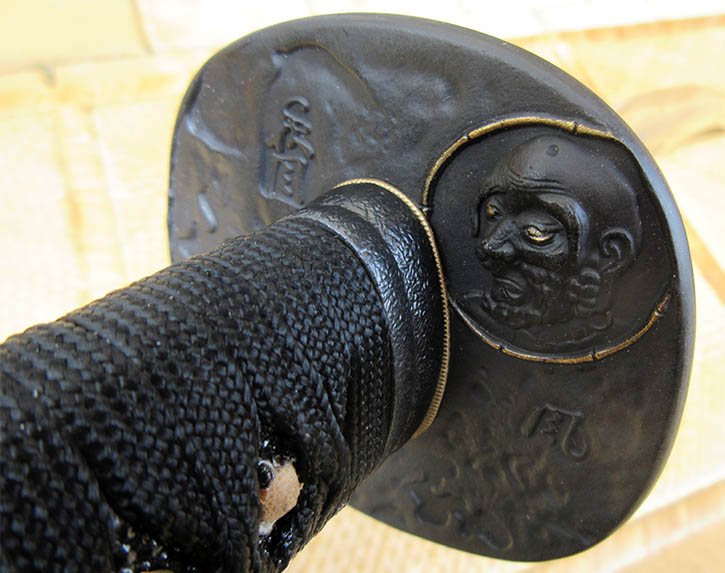
This pattern is only seen on the side facing the wielder (the ura) while the outside, the omote, gives an opponent only a dark, rough looking shape.
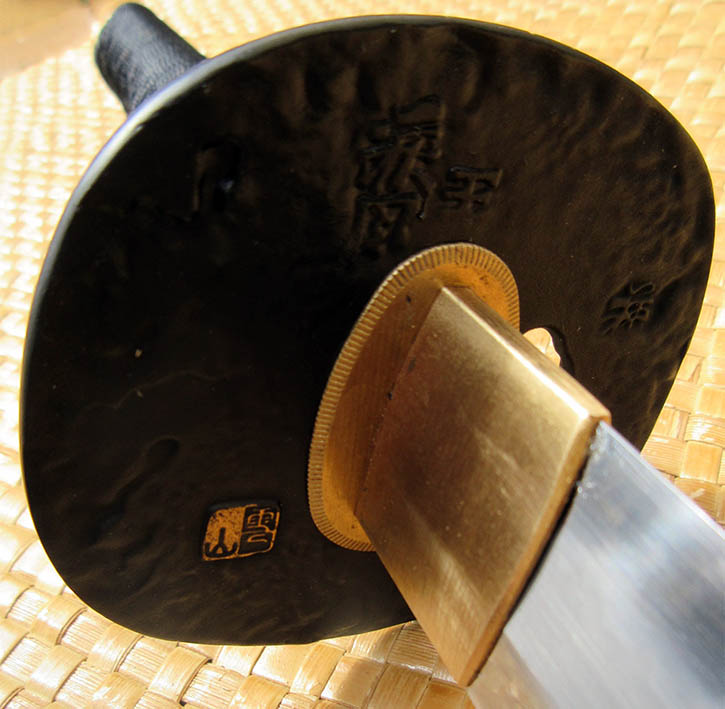
The Fuchi and Kashira fittings are also made of iron with a black finish and textured pattern.
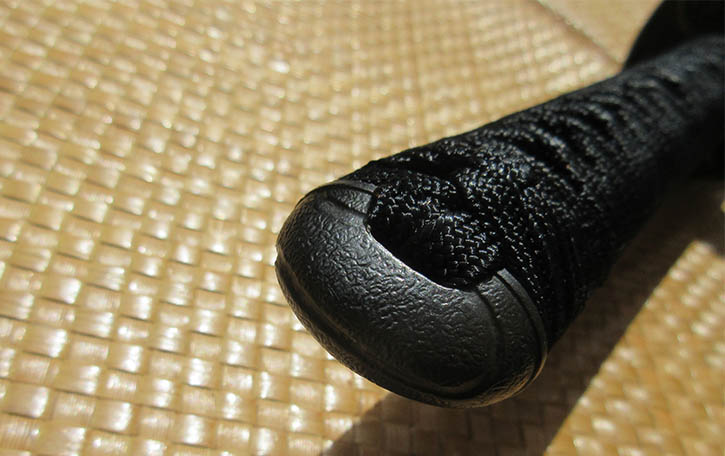
Overall, I achieved my goal of creating a foreboding design and would not have had to pay an extra penny over the base price for all my selections with the final price coming out to a very reasonable $699.99 - so the O-Katana would be somewhat 'brighter' and with a few of the optional extras.
To achieve the look I was after, I selected the black ito again but this time with traditional white rayskin.
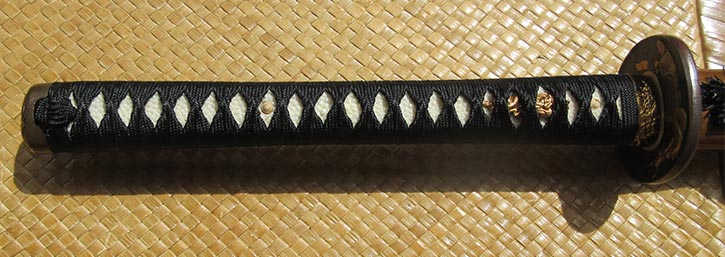
Because so much of the value of these swords is in the blades, we opted not to wrap the swords with hishigami (paper triangles) so while super tight and alternating, the diamonds are not perfectly aligned, which is about the only flaw on these swords I could find so far.
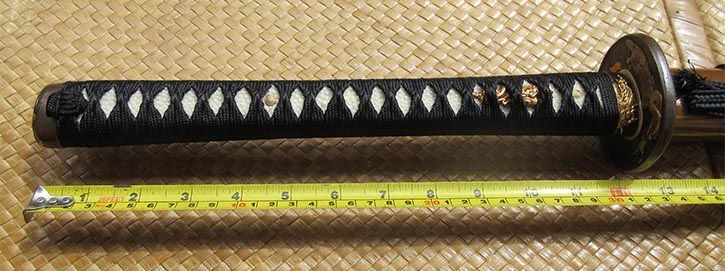
The handle is exactly 12" long on the O-Katana, slightly shorter on the Muramasa, and has a nice shape so feels very comfortable in the hand.
For this design I skipped over the free iron sets, selecting the 'optional upgrade to elite fittings' in the dropdown menu and splurged an extra $29 on a complete work hardened copper set from the optional extras page - the "T009 Elite Set - Goddess dispatches a Dragon".
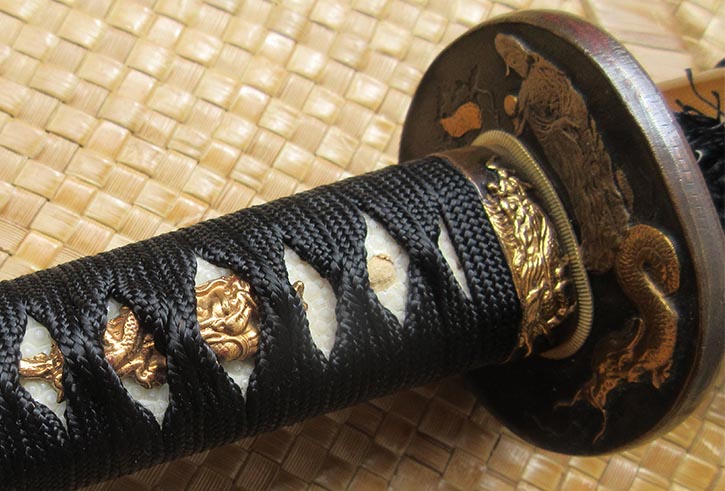
These sets include a tsuba, matching themed fuchigashira and menuki and actually cost a small fortune ($49-$99 plus shipping at most other places) as they are cast from work hardened copper and hand pained with real silver and gold accents.
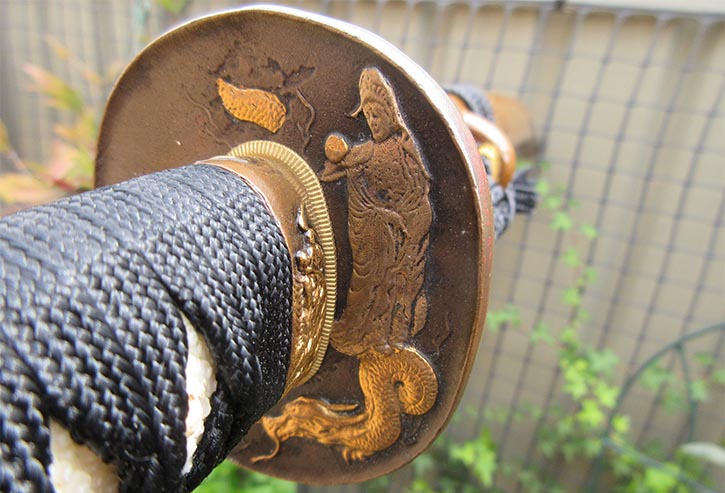
You can see every single available custom option in high resolution on this page of the SBG Sword Store Blog.
Below is a close up of the silk ito and rayskin. The rayskin itself is a very nice cut, with large nodes and is clearly reserved for the best Samurai swords the smiths make. Indeed, later I was able to see just how thick these panels are - they are almost a full wrap!
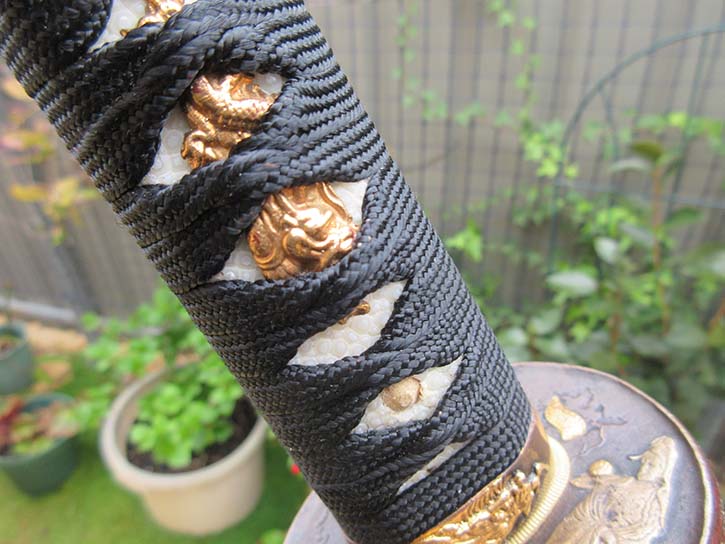
The only flaw I could find was on the kashira - the gold paint application was a little off here and there, though only really noticeable up close and if you are looking for it.
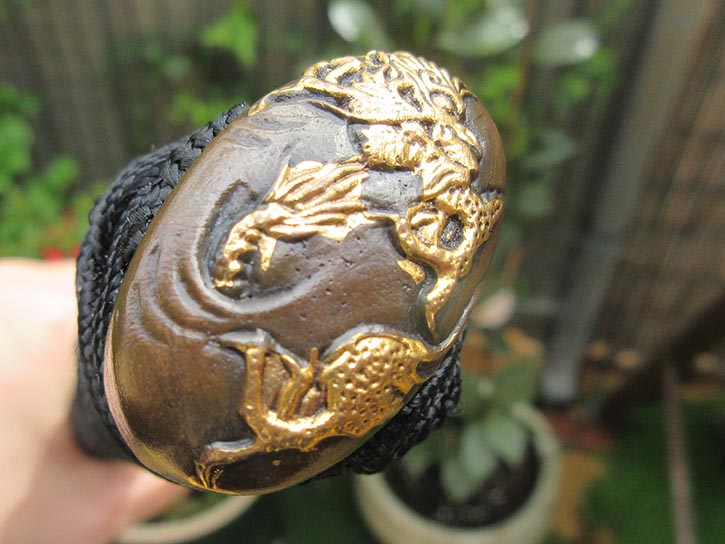
I do not know if this is across the board or was just a case of whoever applied it rushing a bit before lunch or home time, but considering the raw cost of materials, I can see why they would not throw it away and start again for a few slightly off center daubs (to give you some indication of the costs involved using real gold paint, a good iron tsuba can be had for around $20, add some gold paint and its more like $60-70).
One thing that was quite perfect, however, was the saya.
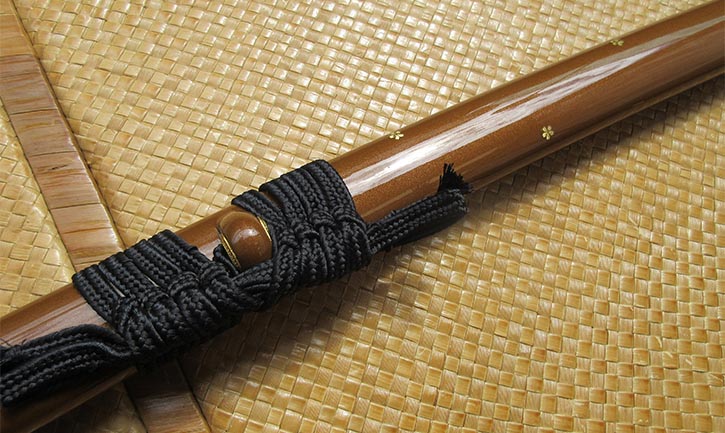
There is a huge variety of saya available for the Forge Direct Custom Katana - 35 to be exact. The first 12 are stock standard, but the remaining 23 get progressively more ornate and attractive - ranging from mother of pearl inlays and hand painted, stunning designs never seen before on even the best Samurai swords simply because, they are so darned expensive.
But with Forge Direct, we absorb as much of the cost as possible - and this saya, golden brown with maki-e (gold speckling) with gold leaf Sakura flowers here and there was just $39 extra..
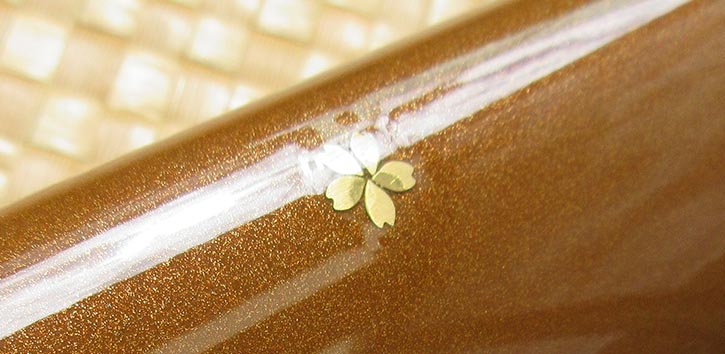
The saya completed this design, and reminded me of the kind of saya you might see belonging to a Daimyo (Feudal Lord)..
So to quickly recap, the blades were awesome, fittngs all as ordered and expected and the only real flaw, some gold paint dabbed imperfectly on the tsuba - base cost of $799 for the O-Katana with just under $70 of extras.
But the big question now is - how did they handle? And even more importantly, how do they cut straight out of the box..?
Handling
The first question - handling, is very easy to answer.
The shorter Muramasa inspired Katana is one of the fastest, most agile blades I have had the pleasure of using.
Part of it is the design - a 1" shorter than the standard 28" Katana blade with partial bo-hi and solid iron fittings all tend to shift the balance towards the handle.
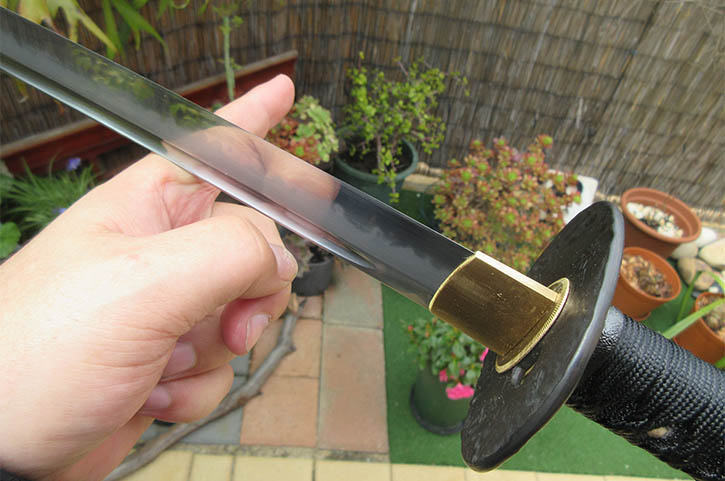 Excuse the less than perfect pic, hard to balance a sword on a finger tip and take a photo at the same time!
Excuse the less than perfect pic, hard to balance a sword on a finger tip and take a photo at the same time!The point of balance comes in at 5" from the tsuba and it weighs approx 2lbs, certainly only an ounce or two over (I had to estimate, but on average - depending on your choice of fittings - these swords weight between 2-2.4lbs).
This gave it amazing speed and makes it one of the best Samurai Swords I have played around with for sheer responsiveness by far.
You would think that the O-Katana with its 33" blade and no bo-hi to lighten it would be sluggish.
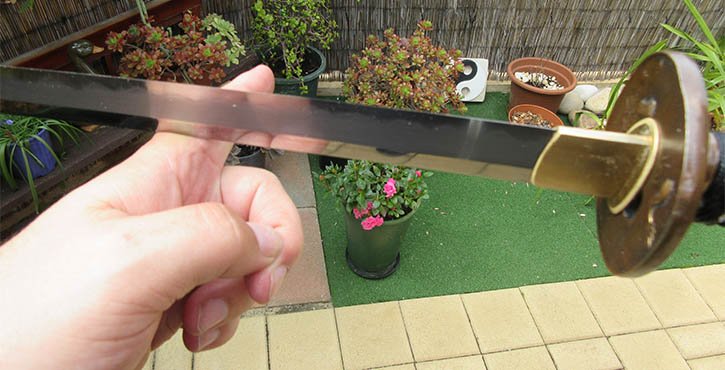
And you would be wrong.
Balanced at 6" from the tsuba, it is not as fast as the Muramasa clone, but for such a long blade, is very, very easy to wield.
Interestingly, when balancing the swords for the photos, I noticed a slightly odd phenomenon. While most Katana sit flat when balanced on one finger, both of these would tilt upwards with the cutting edge facing the sky (better that than the other way, as I would have lost a finger!).
It was a curious thing and made them feel somehow more alive and may well down to their exceptional handling.
Cutting Tests: The real reason why I call these the best Samurai Swords..
I call these the best Samurai swords not because they look amazing, handle extremely well and are - for what you get - incredible bang for the buck.
The real reason they are the best Samurai swords in my opinion is their cutting ability and sheer quality of the blade.
While a paper cutting test can only tell you so much, it was especially eye opening when compared with a different Katana priced closer to $300 that I was testing at the same time as these..
But the real proof of the pudding is in the cutting of light and not so light targets. Only the best Samurai swords can handle both - and it takes a lot of skill to make a blade that can handle the light stuff and not chip or break on something more demanding..
Water filled bottles were cut without any effort at all. From the video below you will get some idea of how easily they are cut - as too are pool noodles, a surprisingly challenging target that only the keenest swords will cut as they 'flop' away from anything that is less than crazy sharp.
But conversely, they were also tested on some aged, thick, hard and nasty bamboo - and finally, a coconut..
Only the best Samurai swords can handle both ends of the cutting spectrum.
The clean cuts on the hard bamboo left not a mark on the blade.
And despite my inability to line up a decent cut on the coconut a couple of times, when I did finally hit it straight - it sliced it easily..
On the popular TV show, Forged in Fire, splitting a coconut with a blade has broken or twisted many a blade. But when I checked the blade afterwards, it was as if it had never happened - the edge was as keen and beautiful as when it arrived..
Conclusion
The hamon on these swords is up there with the best Samurai swords anywhere in the world, I showed the pictures to some Japanese sword friends without telling them where the swords were made and they thought they were real Shinken made in Japan (one even thought he knew the smith!)..
Fittings are the best available to the forge, all iron or all work hardened copper. No alloys, no shortcuts and priced so low we might as well be giving them away.
But it is the handling and the cutting ability of these Katana that truly separates them from the herd.
And I must admit, the process of designing your own is hugely enjoyable. And better yet, we guarantee that you will actually get what you designed and to date (touch wood) have had a 100% QC pass rate in all areas..
PROS
- Art sword quality natural, unetched and unenhanced real hamon.
- Amazingly and consistently sharp blades straight out of the box.
- Premium quality fittings.
- Great assembly - everything fits together as it should. Tight Ito, nice saya fit.
- Versatile cutting ability - from light to challenging targets with no sweat.
- A huge variety of customization options. Keep it simple or go crazy, the choice is up to you (and you get what you ordered).
- Free worldwide shipping and fast construction. Not months but 4-6 weeks.
CONS
- Minor cosmetic issues with the evenness of the ito diamonds (no hishigami) and gold inlay on one part of the kashira.
- Occasionally may fall a few weeks behind schedule.
First time I have ever done it, but despite the price, knowing how low the mark up is and having experienced the process first hand - the only rating suitable is 5 out of 5..
I guarantee you will agree that these are the best Samurai swords you can get hold of for this price point - there is only one other brand (Project X) that we have created that stands above them, but they cost a few hundred more and take 3-4 months to make (and are a different style entirely really - these are the more practical alternative, fully utilizing the strengths of modern crucible steel).
After your first cut, you'll understand just how much bang for your buck you are holding..
WHERE TO BUY
Unfortunately the Forge Direct Sword project was shaken by a rather nasty personal betrayal from our 'business partners' at 'Ronin Katana' and then walked straight into the crazy trade wars of 2025, with the project coming to a complete halt on the 18th of November 2025.
I hope this information on what I feel to be the best Samurai Swords currently available at this price point has been helpful. To return to High Quality Katana from Our Best Samurai Swords: Forge Direct Custom Katana Review, click here

Buying Swords Online Can Be DANGEROUS!
Find the Best Swords in the:
Popular & Recommended ARTICLES

The ONLY true free online magazine for sword enthusiasts. Delivered once a month on the 1st day of the month, no filler and no BS, just the latest sword news & info delivered straight to your inbox.












